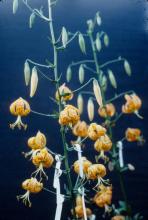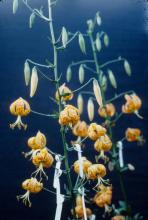I got these in a packet of L. canadense seed, but I suspect they are michiganense or hybrids. Strongly recurved petals, blunt shaped petals, blooming 10 days later than the canadense. Any opinions?
Comments
Rick, I agree, but the
Rick, I agree, but the experts on the other forums are split 50-50 on canadense vs. michiganense. I looked it up in Synge, Lilies, and he implies that there is a continuous gradation in characteristics as you move west from the Atlantic coast through Ohio, etc. So there may not be a clean answer here. But why did they bloom ten days later than the other plants in the seed lot? The same thing happens with the western USA species and the Chinese species. Continuous variation over the range. Maybe it's best to emulate the great Alfred E. Neuman.

Gee, I forgot to say how
Gee, I forgot to say how impressed I am with such a huge inflorescense!
I thought I was doing well with one that has 17 buds....
All other things being the same, 10 days in a lot of time. Have the tepals recurve anymore? If they have, then I think the earlier photos are a bit deceiving and throwing the "canadense" camp off track.
I'll take another look
I'll take another look tomorrow.
Speaking of inflorescenses, here's my best one for this year. The fence in the background is 6 feet tall.
And here is my best one ever (L. ocellatum). I don't remember how many buds it had. It was about 8 feet tall.
It takes a few years for lilies to get this big. The trick is to keep them alive for long enough.
Maybe this is an
Maybe this is an insignificant or limitted observation, but I have only seen pics of large L. canadense inflorescenses that begin with an umbel like arangement at the base with either more umbel(s) above, or with a staggered raceme arrangement above. However with L. michanense, it is common to begin with an umbel like pattern, then some scattered buds with a stagered raceme pattern AND THEN back to an umbel like pattern. (This is what your pic shows, and mine below:
On the other hand, it is very common for L. michiganense to have varying pedicel lengths and angles,and not so much (or at all?) with L. canadense.
Rick, I'm not sure which pic
Rick, I'm not sure which pic you are referring to. By the way, the big canadense stem in post #5 came from the same seed lot as the mystery stem in the first post. They don't look similar to me at all.
The photo below shows the entire group from that seed lot, except for the two stems in post #1, and there is a lot of variation from plant to plant. Also, the two stems in the first post are fasciated, which explains the huge bud count. But the stem in post #5 is not fasciated, as far as I can tell.
Another view:
Note that the two mystery stems on the left have not begun to bloom yet. I find that unusual. But the amount of variation in this seed lot is big anyway. By the way, nearly every lot of canadense that I have grown exhibits this degree of variability, even so-called wild-collected seed.
Mirro wrote:
[quote=Mirro]
Rick, I'm not sure which pic you are referring to.
[/quote]
The very first pic in this thread. But if it is fasciated, then my point about bud arrangement in that pic is moot, as fasciation screws up normal bud arrangemnt.



I suppose they could be a hybrid if the tepals don't reflex completely, but otherwise, they look completely L. michiganense to me.
The Flora of North America distinguishes shows some differences.
.http://www.efloras.org/florataxon.aspx?flora_id=1&taxon_id=118558